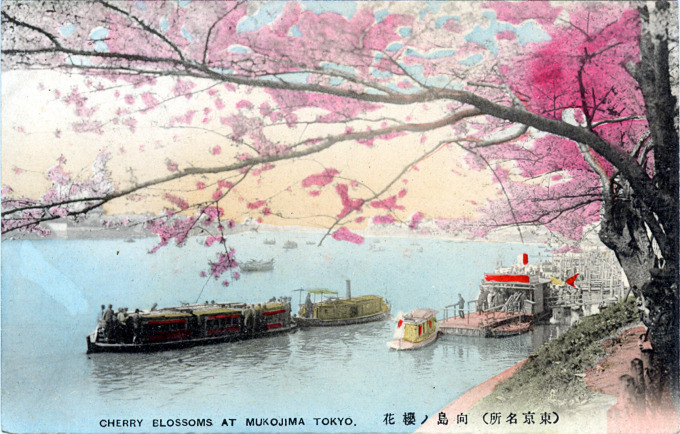
Cherry Blossoms at Mukojima, c. 1910, across the Sumida River from Asakusa. Excursion boats tie up, bringing crowds of visitors each spring to Mukojima’s famous cherry trees during o-hanami.
See also:
O-hanami (Cherry Blossoms Viewing).
Yaomatsu Restaurant, Mukojima, c. 1910.
Koganei Cherry Blossoms, c. 1910.
“There is a river with arched bridges, and along the bank a road bordered on either side, for miles and miles, with cherry-trees. They have no fruit; only blossoms.
“When April comes the newspapers report the cherry-trees in bloom, and it seems as if the influence of those far-off blossoms finds its way into the dustiness and dinginess of that great city; for the workman leaves his work, and the merchant his store, and they go to spend the pleasant April days in the meadow, by the river – under the cherry-trees of Mukojima.”
– The Cherry-Blooms of Yeddo and Other Poems, Clara May Stevens Arthur, 1881
“Mrs. Katsu invited us to go to Mukojima (Yonder Isle) to the Cherry Carnival.
“… How shall I describe the scene presented to my gaze? The lovely arch of pink cherry blossoms overhead, the genial sunshine glinting through the leaves, and the sparkling waves over which every now and then a perfect flurry of snowy petals fell like sweet unmelting snow formed a beautiful background for the picture below; a gaily dressed holiday crowd jostling in holiday merriment, some stopping at the teahouses or refreshment booths which lines the way, others buying masks or toys, charms hairpins and ornaments.
“… Well, in time we reached Mr. Katsu’s summerhouse, a lovely spot just out of reach of reach of the noise and tumble of the carnival, yet surrounded by beautiful cherry trees.”
– Clara’s Diary: An American Girl in Meiji Japan, by Clara A.N. Whitney, edited by M. William Steele & Tamiko Ichimata, 1979
“On the east bank of the river Sumida is a long avenue of cherry trees extending over a mile along the banks. In early April when the blossoms are in its best, when one walks along the banks one feels as if he was going through a ‘flower tunnel.’ It is the merriest season of the year and crowds went thither pleasure-seeking during the time, especially on Sundays and Holidays.
“Tourists who visit the capital in that season should not miss the opportunity to be there. There are many suitable restaurants and tea houses on the way well shaded under the trees which present picturesque views. There is also a University Boat-House on the banks from which annual regattas are held by the students of the Imperial University and other institutions during the season.”
–Up-to-date Guide for the Land of the Rising Sun, H. Hotta, 1902
Views of Mukojima, c. 1910
- Cherry Blossoms in Mukojima at Tokyo, c. 1910.
- Cherry Blossom at Mukojima, Tokyo, c. 1910.
The Groves of Mukojima
Love, let us go the groves of Mukojima;
Fairy pink petals float down through the air:
Come with me love, with me, come to Mukojima,
Merry time, cherry time’s waiting us there.
Smiling the gods in the groves of Mukojima,
Sweet floats the incense from temple and shrine;
Worshippers kneeling in prayer to their idols,
I, too, a worshipper, kneeling to mine.
Love wilt go with me, go to Mukojima?
Idol of idols, and moon of my night;
Butterfly maidens with cherry bloom laden
Shall dance for thy pleasance till morn’s rosy light.
– “The Groves of Mukojima”, by Carrie Shaw Rice, The Japan Magazine, September 1917
- Cherry Blossoms in Mukojima, Tokyo, c. 1910.
- Excursion boats motoring upstream past villas on the Sumida river at Mukojima, c. 1910.
The area of Mukojima, on the east bank of the Sumida River across from the Asakusa temple district, gained favor during the Tokugawa era as one of nine hunting grounds established for the Shogun. It was the “Falcon Shogun,” Tokugawa Yoshimune, who planted the orchard of cherry trees found along Mukojima embankment that later generations would venerate and flock to every spring for O-hanami [cherry blossom viewing].
As it was only a short ferry ride across the Sumida from Asakusa, the common folk would gather amidst the spring blossoms. The literati of the Edo period sojourned there, too, for inspiration, while the politicians and tycoons of the Meiji era built villas at Mukojima as retreats.


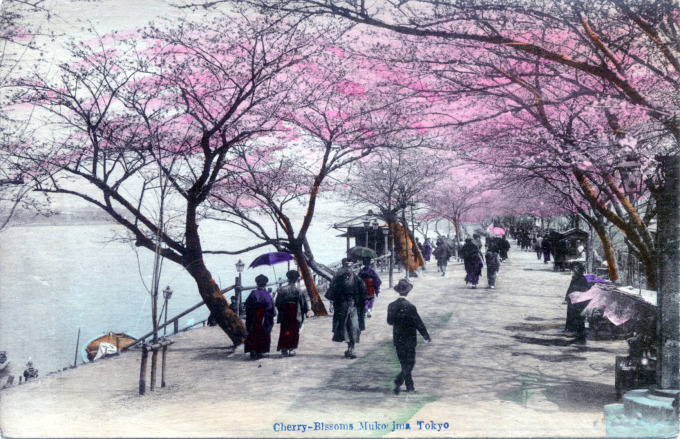
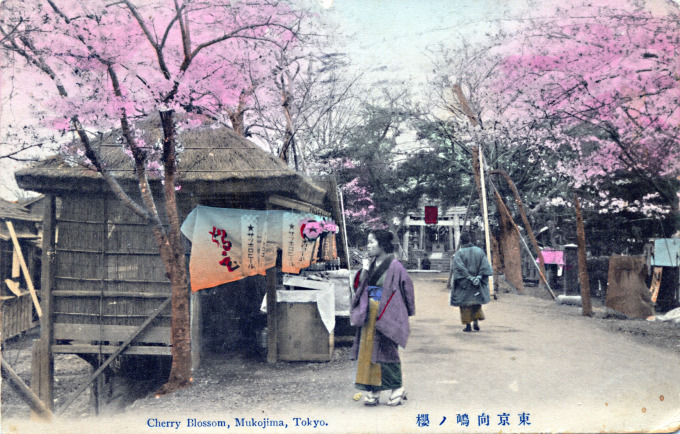
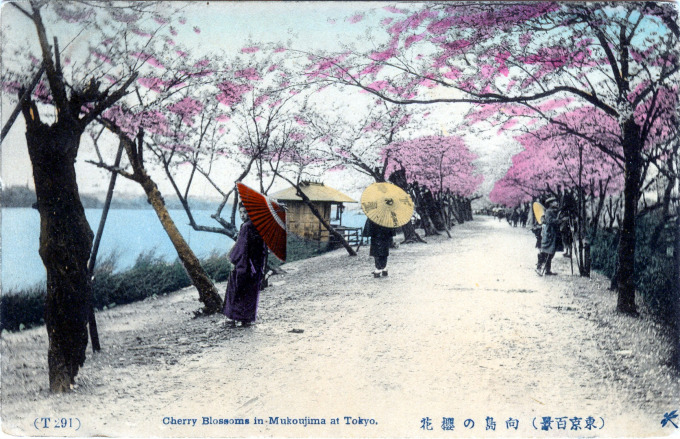
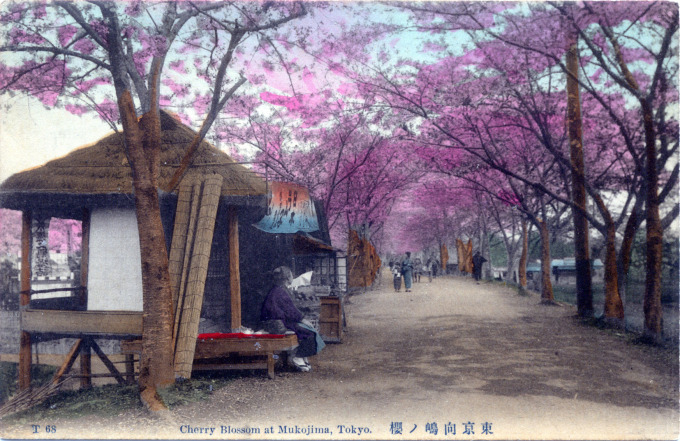
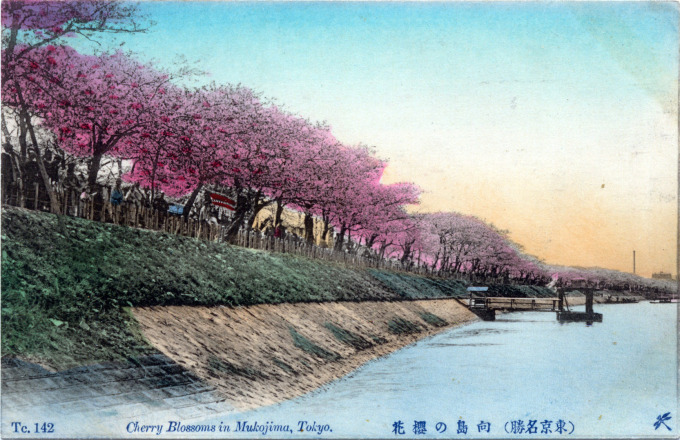
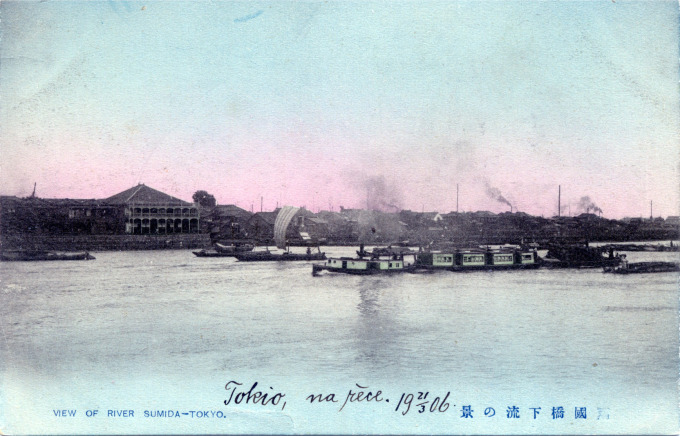
Pingback: O-hanami (Cherry Blossom Viewing) | Old Tokyo
Pingback: Koganei Cherry Blossoms, c. 1910. | Old Tokyo
Pingback: Tokyo Park Inspired D.C.'s Cherry Trees | A Great Blooming
Pingback: Tokyo Park 'Mukojima' Inspired Washington's Cherry Trees
Pingback: Children playing under cherry blossoms, c. 1960. | Old TokyoOld Tokyo